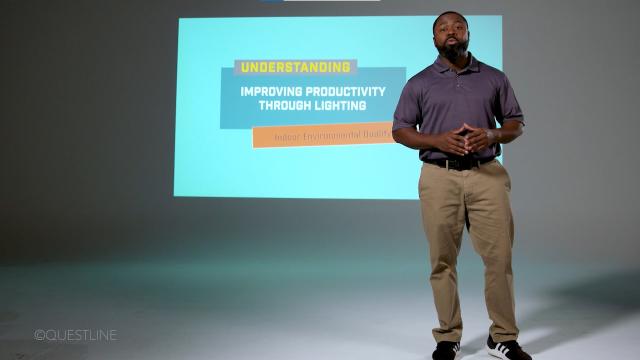Lighting plays a critical role in the indoor environmental quality (IEQ) of your building. Lighting design, light levels, color tone, light quality, access to daylight and occupant controls can all help improve IEQ, and in turn lead to healthier, more comfortable and more productive occupants.
Lighting design
Achieving uniform light with no bright or dark areas within a space helps improve vision and reduces the risk of accidents. It has been shown to improve the mood and focus of occupants.
Light levels and color tone
The ideal illuminance and color temperature of lighting is based on the function of a space. For instance, a warmer color temperature could set a mood in a restaurant. Brighter light is more effective when occupants need to focus on details, such as reading.
Light quality
Higher-quality lighting can also improve eye comfort, reduce headaches from eye strain and improve productivity. Research has shown that bright, high-quality lighting can reduce errors during tasks, such as filling prescriptions or pulling orders at a warehouse. It can also improve the performance of students in academic settings.
Access to daylight
Access to daylight can produce amazing effects by harnessing people's circadian rhythm. Circadian rhythm is the natural energy our bodies have connected with the cycle of the sun. It can increase alertness while improving mood.
Daylight or artificially produced daylight can have amazing benefits for health, happiness, productivity and sales.
- Health — fewer absences for students and employees and shorter hospital stays for patients.
- Happiness — occupants report being in a better mood.
- Productivity — a more efficient and effective workplace.
- Sales — increased sales in retail settings.
Occupant controls
It's also important to remember that light may affect different people in different ways, and the function of the same space may change from day to day or even hour to hour.
Including adjustable controls allows occupants to maximize comfort and productivity when baseline settings don't meet their needs. This could be as easy as providing task lighting in certain areas. That way, the occupant only needs to light the space being used without affecting other occupants.
Improving productivity through lighting
- Lighting can play a huge role in the health, comfort and productivity of building occupants.
- The design, quality, color temperature and levels of light all play roles in how the light is perceived.
- Access to daylight or simulated daylight can take advantage of the circadian rhythm that people naturally possess.
- Occupant control ensures that the most productive lighting can be achieved for any occupant at any task.
Understanding how lighting improves the overall IEQ of your building can pay big dividends for your business.
November 2023 Connections Newsletter
Learn how good lighting plays a critical role in improving the indoor environmental quality of your building.
Full Newsletter